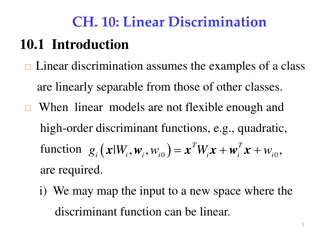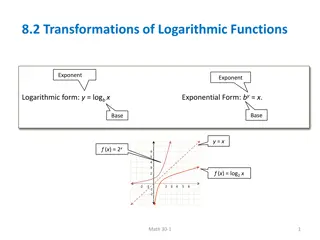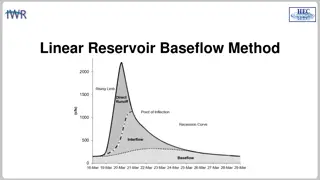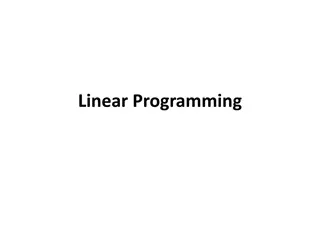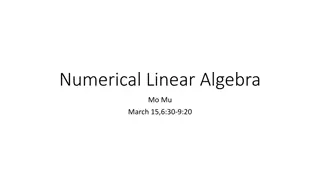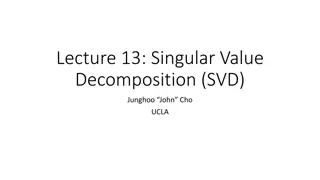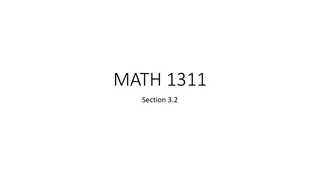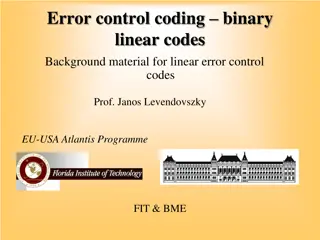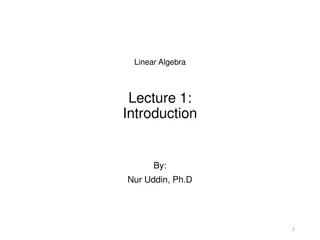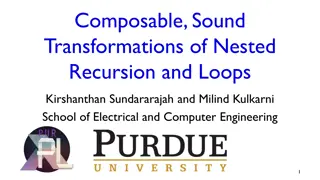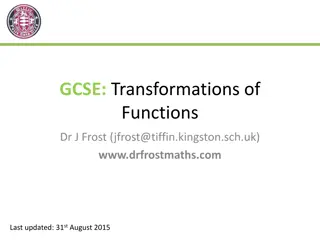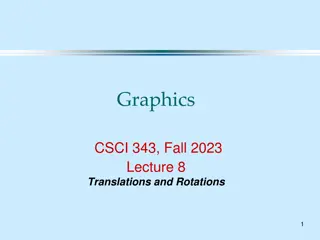Understanding Linear Transformations in Real Analysis
In Real Analysis, linear transformations play a crucial role in vector spaces. This content delves into the definitions of linear combinations, independence, dimensions, bases, and theorems related to vector spaces. Explore how sets of vectors can span a space, the concept of bases, and the uniqueness of representations in vector spaces. This study aids in grasping the fundamental concepts essential for a deeper understanding of Real Analysis.
Download Presentation

Please find below an Image/Link to download the presentation.
The content on the website is provided AS IS for your information and personal use only. It may not be sold, licensed, or shared on other websites without obtaining consent from the author.If you encounter any issues during the download, it is possible that the publisher has removed the file from their server.
You are allowed to download the files provided on this website for personal or commercial use, subject to the condition that they are used lawfully. All files are the property of their respective owners.
The content on the website is provided AS IS for your information and personal use only. It may not be sold, licensed, or shared on other websites without obtaining consent from the author.
E N D
Presentation Transcript
Real Analysis Ms.A.Benazir Assistant Professor of Mathematics Department of Mathematics, Hajee Karutha Rowther Howdia College.
Linear transformation: Linear transformation: Definition: Definition: A non-empty set X R is a vector space, If x+y X x X x X, y X and for all scalar C If x1,x2, ..xk R and c1,c2, ck are scalars, Then the vectors c1x1 + c2x2 + . + ckxk is called a l linear combination inear combination of x1,x2, xk. If S R and if E is a set of all linear combination of elements of S then we say that S spans E (or) E is the span of S. Every span is a vector space vector space.
A set consisting of vectors x1,x2,..xk is said to be independent if the relation c1x1+c2x2+ +ckxk= 0 Implies that c1=c2= ..cn=0 otherwise x1,x2, ..xk is said to dependent. No independent set contains the null vector. If a vector space X contains an independent sets of r vector but contain no independent set of (r+1) vectors. We say that X has dimension r. That is, dim X = r
The set consisting of zero alone is a vector space is dimension is zero. An independent subset of a vector space X which span X is called a basis of X. If B = {x1,x2, ,xn} is a basis of X, Then ever x X has a unique representation of a form X = c1x1+c2x2+ .+crxr. r = i cixi That is, X= . 1
Such a representation exist since B spans X, and it is unique. Since B is independent the number, c1,c2, ..cr are called the co-ordinates of X with respect to the basis B. The set {e1,e2, .en} is the basis where ej is the vector in r whose j-th co-ordinate is 1 and all other co-ordinates are zero. If x r and x = (x1,x2, ..xn), then x = x1e1+x2e2+ .+xnen. We shall call e1,e2, en are standard basis.
Theorem : Theorem : Let r be a positive integer. If a vector space S is spanned by a set of r vector. Then, dim X r Proof: Proof: Let S0 = {x1,x2, x0} be the span of the vector space X. Suppose if the theorem is not true. That is, dim X > r It means that X has a set of {y1,y2, ..yr+1} of r+1 linearly independent vectors yi 0, i= 1,2, .r+1.
If y1 X and X is spanned by S0 That is y1 = 1x1 + 2x2 + ..+ rxr. Implies 1x1 = y1- 2x2 - - rxr. x1 = 1/ 1 [y1- 2x2 - - rxr] Since 1 0 Then we get, x1 = c1y1+c2y2+ ..+cryr Therefore the set S1 = {y1,x2, ..xr} be the open set of X for 0 i < r. Let Si = {y1,y2, ..yi,xi+1, ..xr} which spans X.
Then, yi+1=(1y1+2y2+..+iyi)+(i+1xi+1+.+xrr) Suppose i+1 = i+2 = = r = 0. Which is contradiction to the fact that y1,y2, yr+1 is linearly independent. Therefore i+1 = i+2 = = r 0. Assume that i+1 0. xi+1 = 1/ i+1 [yi+1- = j 1 r i jyj- jxj] = + 2 j i Therefore Si+1={y1,y2, ..yi+1,xi+2, ..xr} which spans X.
Similarly proceeding like this, We get Sr = {y1,y2, ..,yr} which spans X. Since yr+1 X, it can be written as, yr+1 = c1y1 + c2y2 + + cryr The set S is linearly dependent. Since yr+1 can be written as linear combination {y1,y2, ..yr}. Which is contradiction. {y1,y2, ..yr} is linearly independent is wrong. Therefore, X contains a set of r vectors and the dimension X r (dim X r ). Hence the theorem.
Corollary: Corollary: dim R = n Proof: Proof: Since {e1,e2, ..en} spans R by the above theorem. We have, {e1,e2, ..en} which implies dim R n (1) {e1,e2, ..en} is independent. Then we have dim R n (2) Hence proved.
Definition: Definition: A mapping A of a vector space X into a vector space Y is said to be a linear transformation, if A(x1+x2) = A(x1) + A(x2) and scalar multiplication. A(cx) = cA(x) for all x1,x2, ,x X and all scalars C. A(x) can be written as Ax If A is linear,A0=0. If A is linear, A of X into Y is completely determined by its action on any basis.
If x1 into xn is a basis of X then every x X has a unique representation of the form n x = cixi = i 1 and the linearity of A allow us to compute Ax from the vector Ax1,Ax2, Axn and the co-ordinates c1,c2, ,cn. By the formula, n Ax = ciAxi = i 1
Linear transformation of X into X are often called an linear operators on X. If A is a linear operators on X which, (i) one to one (ii) maps X onto X, we say that A is invertible We can define an operation A (Ax) = x for all x X Similarly A(A x) = x for all x X and that A is similar.
DEFinition DEFinition: : Let L(X,Y) be the set of all linear transformation of the vector space X into the vector space Y. If A1, A2 L(X,Y) and if C1,C2 are scalars. Define C1A1+C2A2 by, (C (C1 1A A1 1+C +C2 2A A2 2)x = C )x = C1 1A A1 1x + C where x X. x + C2 2A A2 2x x It is clear that C1A2+C2A2 L(X,Y).
Definition: Definition: If X,Y,Z are vector space if A L(X,Y), B L(X,Y,Z). We define this product BA by the composition of A and B. (BA)x = B(Ax) Therefore BA BA L(X,Z). BA need not be AB. Even if X=Y=Z
Definition: Definition: A differentiable mapping f of an open set E R into R is said to be continuously differentiable in E, If f is a continuous mapping of E into L(R ,R ). It is required that to every x E and to every > 0 corresponds a > 0 such that ||f (x)-f (y)|| < . If y E and |x-y| < . We also say that, F is a (E).


